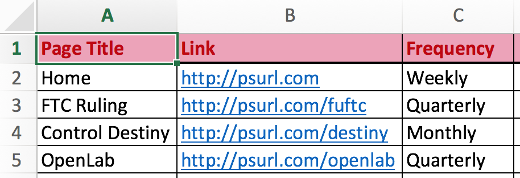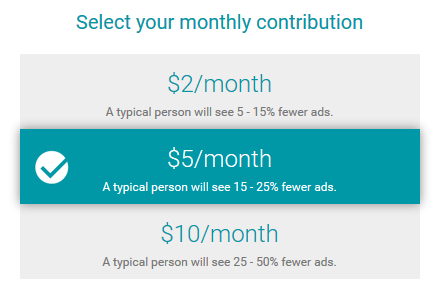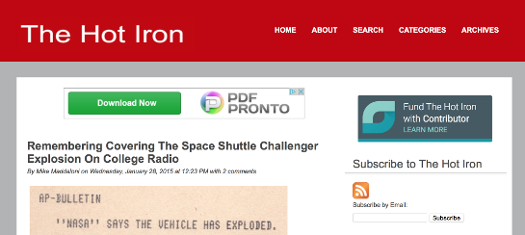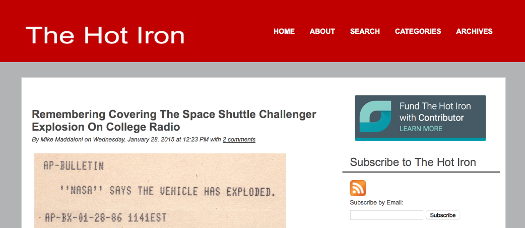The Simplest Web Site Content Plan

Quick – how accurate is your Web site?
My deepest apologies if I caused you to have anything from a puzzled look on your face to a panic attack. But if you own a Web site and have any sizable amount of content, it should be periodically reviewed to see if it needs to be updated.
Where there are tools available to help this – perhaps within your content management system (CMS) where you update your content, or external, third-party tools, I’d like to share a basic, straightforward and low-tech way to remind you to review your content.
From Louisville With Love
In a past role I managed the technical environment for our Web site and Intranet, working with staff from Marketing together as the Web team. One day someone from the facilities department stopped by my desk, and the brief conversation we had went something like this:
Julie (not their real name): “Hey, Mike.”
Me: “Hey, Julie”
Julie: “You know the Louisville, Kentucky office moved, right?”
Me: “Yea, I saw that someplace… why are you asking me?”
Julie: “Because the old office address is still on the Web site – you do something with that, right?”
After that thrilling conversation, I got on the phone with my marketing counterpart (we’ll call her Natasha) and has basically the same conversation with her, however I said Julie’s lines. This was followed by a few choice adult words by both of us, then Natasha proceeded to make the change to the Web site.
Maintaining With a Plan
Still on the phone, we both could hear each other exhale. We were glad we were able to make the change quickly, then the conversation continued around how much other outdated content was out there, updating it, and a plan to do both of these tasks moving forward.
As with many Web sites out there, content has many owners. The marketing teams for each product managed their own content, and Natasha was responsible for the overall “corporate” content. We didn’t have a feature-rich CMS for the site that could alert us to “expired” or “expiring” content, nor were there many decent comprehensive content tools at the market at the time – and we looked – so we had to come up with our own solution.
What we came up with was straightforward yet highly effective, and it came about with these steps.
1. First I listed all pages of the Web site and put it into a spreadsheet. As we had a Sitemap page it made this task easy.
2. Natasha then took the spreadsheet and added a column called “frequency” and proceeded to make the frequency of how often page content should be reviewed (e.g. weekly, monthly, quarterly).
3. I took a look at her revised spreadsheet and made suggestions regarding the frequency – remember, I am much, much more than just a technologist!
4. Natasha, using the final spreadsheet as a guide, created calendar alerts with links to the pages as reminders to review the content.
That was it, and it worked.
Of course some content would be reviewed more frequently, namely when it was modified or other business triggers occurred. The point of the above exercise though was to ensure that, on a regular basis, all of the Web site content would be reviewed for accuracy. In addition to this, I would perform regular link checks to ensure the content was technically connected.
What Works For You?
As you are reading this, I hope you are thinking of the content of your Web site, as there is no time like the present to be thinking about it! In addition to the site itself, your extended Web presence includes your social media profiles and feeds. As it’s easy to tweak one or more and forget about the others, perhaps this “detached” solution of using your calendar will work for you too?
Deconstructing a Web Content Plan
In this hyper-speed world of content development, it’s not unusual to have inaccurate or incomplete content out there, exposed, for all to see. By coming up with a straightforward and highly usable plan, you will be able to get ahead of long-standing errors and omissions in your Web presence.
This is from The Hot Iron, a journal on business and technology by Mike Maddaloni.
Did you enjoy this? Subscribe to The Hot Iron by RSS/XML feed or Read by Email.
Blogging • Business • Strategize • Web Design • (1) Comments • Permalink
7 Lessons Learned From Blogging For 10 Years

On Saturday, December 30, 2006 at 1:56 pm Central US Time, I published my very first blog post here at The Hot Iron. If you didn’t click on the link to read it, it would have taken longer to read this sentence than to read that post. Now ten years and 822 posts later, I am entering my second decade of blogging.
Where every year on my “blogversary” I have written a post to acknowledge it (some more robust than others), rather than simply patting myself on the back again, I’d like to share some of the lessons I have learned over the years of writing.
1. You never know who is reading – Despite knowing the Internet is Earth-wide, I still get amazed as to the reach of what I have written. Whether it’s companies inviting me to dinner or to travel the world, to the one time when someone quoted to me something I wrote myself, the true exposure is something I need to remind myself before I click the publish button each time.
2. Answer a question with a blog post – As the genesis of this blog was out of my former Web consulting firm, I found it useful to use The Hot Iron as not only a means of promoting my business but to create “reusable” content. Whenever someone asked me a question that I believed someone else may ask me, I would create a blog post on it and send them the link in response to their query. It not only answered their question, but made me look smarter as I wrote something on it, and made answering the question the next time all the easier. I still do that to this day.
3. Blogging can help you be a better writer – Before I started blogging, most of my writing was emails and technical specifications and documentation. Over time, I not only honed my writing but found myself greatly enjoying it. Many people have told me that they find it hard to get into a groove on writing, and if you look at my first few posts to those I write today, you will see quite a progression. More on the writing process later.
4. Simply placing ads on your blog won’t make you rich – Some of you may be surprised by this statement, and others of you are surely smirking at it, as you learned this the hard way yourself. From banner ads, Amazon product links to payment services like the former CentUp or soon-to-be former Google Contribute, ads may bring in a little loose change, but it takes a concentrated effort and plan to make real income from your blog.
5. Allow people to subscribe by RSS or email – Many of my most faithful readers are ones who receive my blog posts in their inbox or in their RSS feed reader. Even though Google killed off its Reader product years ago, people still aggregate content by RSS feeds in their Web browser or other services such as Fever. Making it easy for people to read what you write will keep readers reading.
6. Control your blog platform – Over years I have seen people post loyally on a variety of public platforms, from Geocities to Posterous, only to see those services shut down and their content vanish, especially as they never had a backup of their own writing! I am in the business of helping people get their message out on the Web, and I sill profess the best way is to do so is to have control of your Web publishing platform. Your own domain name coupled with any one of the number of content management systems (CMS) out there will give you the ability to manage your message as well as move it if necessary.
7. Blog posts don’t write themselves – Doing the math, I have written and published about 1.5 posts a week. On the surface this looks good, but looking back on early posts – especially those before the social media boom which would have probably been tweets rather than blog posts – there was irregularity and long periods where posts were published and where they were not. It takes a commitment to writing – focusing on actually finishing writing, editing and publishing something. I also like to add original photos to posts, which will take me on a hunt to find the right shot (like the one above at a liquor store – there are worst places to go) and more time. But as I do enjoy writing, it’s also a hunt to find time when I am caffeinated and have thoughts pouring out of my head, as I am as I write this.
Deconstructing Ten Years of Blogging
There are very few things in our lives that we can measure in terms of decades, and I can now count this blog as one of them. For as much work that goes into writing what I share here at The Hot Iron, it is truly something I enjoy doing. This makes the time I have devoted to this labor of love all the more worth it. Feedback from readers rounds out the overall experience, and for that I am also grateful. Now on to post 823.
This is from The Hot Iron, a journal on business and technology by Mike Maddaloni.
Did you enjoy this? Subscribe to The Hot Iron by RSS/XML feed or Read by Email.
Announcements • Blogging • Thrive • (1) Comments • Permalink
Stir The Soul
Congratulations to the Chicago Cubs for winning the 2016 World Series, ending a 108-year championship drought! As a fan of the Boston Red Sox, who ended their own 86-year drought in 2004 – ironically just after I moved from Boston to Chicago – there has always been a kindred spirit between the teams, and I am glad to see them win it all.
As I watched the final out of the game – at home, after leaving the pub where several families and their kids stayed far too late on a school night – I heard the jubilation in the neighborhood of literal screams and shouts. I was happy for the team and Chicago, especially for friends and colleagues – loyal fans who have been waiting for “next year” to finally come.
Though I was happy, I can’t say I was emotional about it. Granted, it was after midnight, but the strong feeling I have experienced when others of my teams – the Red Sox, New England Patriots and even my adopted Chicago Blackhawks – won their championship titles was just not there.
That is, until I saw this. Click on the embedded video below to play it, or click this link to watch the video on YouTube.
The video is from Budweiser and was released on the morning after the game. It is an extremely creative piece, combining modern video of Chicago and its fans watching the game and vintage video and audio of the late legendary Cubs announcer Harry Caray, edited to match the final out of the game. It’s as if Caray was alive today, making the call himself.
This got to me. And I finally felt the emotion I would expect to feel, as I have felt in the past when not only a team of mine won, but for other exciting events in my life.
Why it got to me is not surprising. As someone who grew up in an age before ESPN (interestingly, ESPN founder Bill Rasmussen was a local sports reporter where I grew up before he started the cable network) and the ability to see games all the time, we may have gotten 1 or 2 games a week on TV, but radio was where all games were broadcast. In those days, play-by-play announcers had a much different style than they do today; they were much more conversational, and in the absence of today’s computer-generated bombardment of stats, filled gaps with anecdotes that gave you a broader sense of what it was like to be in the ballpark.
Where I knew about Harry Caray and his antics in Chicago, for me it was Ken Coleman who was the play-by-play announcer for the Red Sox. An older gentleman, his mellow voice was a contrast to today’s announcers, and it was like listening to old Uncle Ken telling the story of today’s game.
To say they don’t make them like that anymore is more than cliché. Where Coleman, as Caray, did not see a World Series for their teams in their lifetimes, it was nice that this tribute to Caray was crafted.
(Edited 7/9/2017 and 7/30/2018 - changed link and embed from the original video to an alternate one as it was no longer available.)
This is from The Hot Iron, a journal on business and technology by Mike Maddaloni.
Did you enjoy this? Subscribe to The Hot Iron by RSS/XML feed or Read by Email.
Announcements • Blogging • Diversions • Thrive • (0) Comments • Permalink
Ridin’ Writer’s Block Out

A few days ago I experienced something I never have before in my life. And looking back now, that was ok.
I had writer's block.
Over the last decade of blogging I have grown to love writing. What started out as cranking out a few paragraphs for my first dozens of posts here at The Hot Iron has grown to a passion for writing out – ok printing, but on paper – what I have sketched out and organized in my head and then type up to post. This is a similar approach I take with writing for my day job, as well as guest posts I have made on other blogs and sites.
As I write this in the first week into June of 2016, I look back and I did not post anything on the blog during the month of May, making for one of the longest recent stretches for me. Where I can say with confidence I did a lot of other things over the past month, both professionally and personally, I did not spend any “me” time to write. With that as a cloud over my head (ok, a thin cloud, but sun-blocking nonetheless) I tried to force the issue and do some writing.
A window of opportunity presented itself, with a meeting being canceled during noontime, and I saw this as my chance to get in some writing. I grabbed my notebook, pen, and headed for one of the few local Starbucks where I have written much of what I have written in the last year. After pouring a little whole milk in my grande dark roast I spotted an open seat at the tall table where I like to sit, put my stuff down, took a sip as I opened my notebook... and just stared at the blank page.
And I stared for what seemed like an eternity. I had a couple of topics to choose from, however nothing seemed to go from my brain to my hand to my pen. I even tried to go back and look at something I had started previously, and simply X'ed it out writing “trash” over it. Trying harder to focus didn't work either, as my mind was more focused on the sounds of the espresso machine and Frappuccino® blender, not to mention the people walking outside of the store. I was besides myself as I had been able to focus while sitting at this very same table where in the past the other 5 stools were occupied by police officers and I was able to tune them out! Realizing I had spent about 40 minutes and was only able to choke out not even 1 page of something I haven't looked back on yet, I closed my notebook, grabbed my coffee and made my way back to the office.
Not My Time
As I sauntered back to the office, frustration segued to reality as it came to me – this was not the time to try to write. Where everything else lined up into place – an hour of time, dark roast available brewed and not as a pour over – the one thing that was not ready was my brain. I had too many things on my mind, everything from the work I had to go back to when I returned to the office as well as everything else going on in my life. Forcing it right then and there wasn't going to change the situation, so I just needed to find another time to do it. Like right now, several days later, where the words are flowing faster than I am able to type them.
In the end I simply need to ride out writers block. And that phrase – ride out – came to me as well as I was walking back to the office, where the only real thing I was concerned with was avoiding panhandlers and other pitch people on the sidewalks. Of course my brain, which was schooled in 80's rock music, quickly dropped a needle on an old REO Speedwagon album, playing “Ridin' The Storm Out” over and over as I wrote this. However unlike the other day, the song served as an inspiration and not an impediment.
Deconstructing a Writer's Block
Over the years I certainly wouldn't say every time I sat down to write was an ideal time. This one time was the worst of them all. No beating myself up over this “lost” 40 minutes is necessary either. Had it not been for it, I wouldn't have written what you are reading now, or thought of that REO Speedwagon song, or gotten myself psyched up to write some more. The creative process can't always be controlled.
If you're not familiar with the song in my head, you can watch the video embedded below, or if you can't see it you can click on this link to view it on YouTube. Interestingly, this video was recorded on my 18th birthday.
This is from The Hot Iron, a journal on business and technology by Mike Maddaloni.
Did you enjoy this? Subscribe to The Hot Iron by RSS/XML feed or Read by Email.
Blogging • Strategize • Thrive • (5) Comments • Permalink
Google Contributor Offers Interesting Approach To Blog Revenue
Editor's Note: Google Contributor is no longer operating for general use as indicated below, and this post was edited to remove links to their Web site and embedded elements that are no longer functioning.
Would you pay money to read The Hot Iron? And what if by paying you saw less ads on the site?
I know I have asked this question before when I added CentUp to this very blog. Another new revenue model for writers has come about from Google called Contributor. As I have no illusions (delusions?) of grandeur in earning a living from this very site alone in itself, I was more intrigued to try it to how it really works.
How It Works
Google Contributor allows a Web user to contribute money monthly for ads to not be shown on Web sites it visits. The ads specifically are ones from Google’s own ad services, AdSense and DoubleClick. So if a banner ad comes from another source other than Google (and there are many) that ad will still appear. In the place of the ad it may be blank or a thank you message for supporting the particular Web site.
From the Web site owner’s perspective, if they are displaying on their site through Google, rather than getting the money for someone seeing and clicking on an ad, they are getting money from the user’s Contributor account, in a sense offsetting the cost of the ad usually paid by the advertiser.
A few items of note on Contributor. Currently it only works in the US. By someone contributing money, either US$2, US$5 or US$10 a month, they are still going to see ads. As shown in the chart below, by contributing those 3 previously mentioned dollar figures, they will see respectively 5-15%, 15-25% or 25-50% fewer ads. These fewer ads are across all Web sites with Google ads not just one in particular. So if you contribute $10 a month, thinking it will all go to me for reading The Hot Iron, it will not.

Is It Worth It?
That’s a great question – is it worth it? I honestly don’t know, as I have just set it up on the blog, and I have also signed up as a Contributor at the whopping US$2 a month level.
Here is a screenshot of this blog with an ad appearing at the top:


I know – the difference is amazing!
It will be interesting to see how often I notice the ads not there. Last year was the 20th anniversary of the Web banner ad. As I heard somewhere – and I forgot the source – it was marking 20 years of people ignoring banner ads! So even if it technically works, it will be interesting to see if anyone notices.
Are you a Google Contributor? Did I convince you to join, or not join? I welcome your thoughts in the comments of this post.
This is from The Hot Iron, a journal on business and technology by Mike Maddaloni.
Did you enjoy this? Subscribe to The Hot Iron by RSS/XML feed or Read by Email.
Blogging • Business • Technology • Web Design • Web Development • (2) Comments • Permalink




